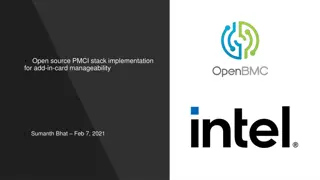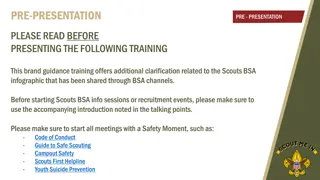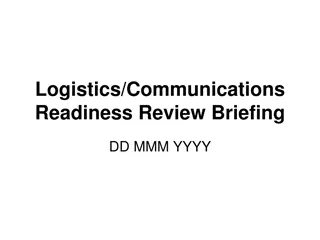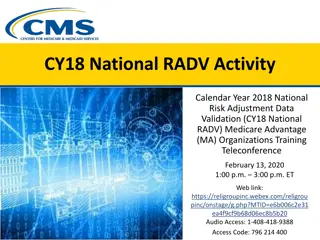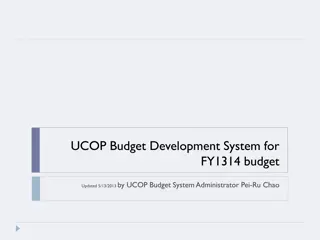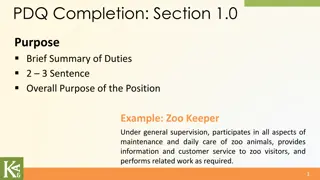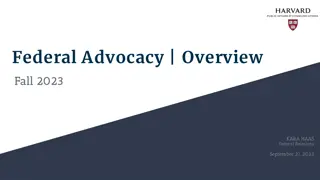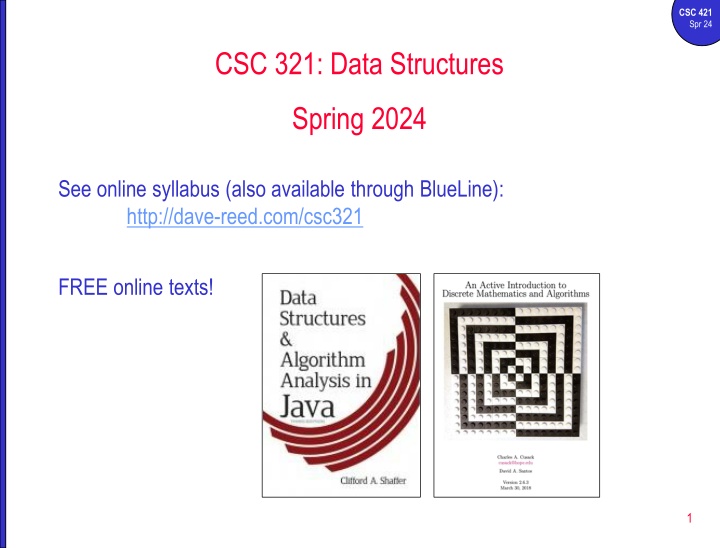
Effective Data Structure and Algorithm Analysis for CSC 421 Course
Explore the fundamental concepts of data structures and algorithms in the CSC 421 course for Spring 2024. Topics include lists, stacks, queues, sets, maps, mathematical structures, efficiency evaluation, program design, and more. Enhance your problem-solving skills and learn to select appropriate data structures for various problems. Dive into data-driven programming and analysis with real-world examples like dictionary lookups. Get ready for a comprehensive understanding of computer science essentials.
Download Presentation

Please find below an Image/Link to download the presentation.
The content on the website is provided AS IS for your information and personal use only. It may not be sold, licensed, or shared on other websites without obtaining consent from the author. If you encounter any issues during the download, it is possible that the publisher has removed the file from their server.
You are allowed to download the files provided on this website for personal or commercial use, subject to the condition that they are used lawfully. All files are the property of their respective owners.
The content on the website is provided AS IS for your information and personal use only. It may not be sold, licensed, or shared on other websites without obtaining consent from the author.
E N D
Presentation Transcript
CSC 421 Spr 24 CSC 321: Data Structures Spring 2024 See online syllabus (also available through BlueLine): http://dave-reed.com/csc321 FREE online texts! 1
CSC 421 Spr 24 Course goals To understand fundamental data structures (lists, stacks, queues, sets, maps, and linked structures) and be able to implement software solutions to problems using these data structures. To achieve a working knowledge of various mathematical structures essential for the field of computer science, including graphs, trees, and networks. To develop analytical techniques for evaluating the efficiency of data structures and programs, including counting, asymptotics, and recurrence relations. To be able to design and implement a program to model a real-world system, selecting and implementing appropriate data structures. 2
CSC 421 Spr 24 221 vs. 222 vs. 321 221: intro to programming via scripting focused on the design & analysis of small scripts (in Python) introduced fundamental programming concepts variables, assignments, expressions, I/O control structures (if, if-else, while, for), lists functions, parameters, intro to OO 222: object-oriented programming focused on the design & analysis of more complex programs (in Java) utilized OO approach & techniques for code reuse classes, fields, methods, objects interfaces, inheritance, polymorphism, object composition searching & sorting, Big-Oh efficiency, recursion you should be familiar with the concepts from 221 & 222 we will do some review next week, but you should review your own notes & text 3
CSC 421 Spr 24 221 vs. 222 vs. 321 321: data-driven programming & analysis focus on problems that involve storing & manipulating large amounts of data focus on understanding/analyzing/selecting appropriate structures for problems standard collections (lists, stacks, queues, trees, sets, maps) mathematical structures (trees, graphs, networks) analysis techniques (counting, asymptotics, recurrence relations) as problems grow in size and complexity, choosing the right algorithm and data structures are essential e.g., phone book lookup, Sudoku solver must develop problem-solving approaches (e.g., brute force, backtracking) be able to identify appropriate data structures (e.g., lists, trees, sets, maps) 4
CSC 421 Spr 24 Example: dictionary lookup you are given a large dictionary of 100K+ words want to be able to store and lookup words data structure/algorithm options 1. 2. 3. 4. store in an unsorted ArrayList, perform sequential search insert into a sorted ArrayList, perform binary search store in an unsorted ArrayList, sort before each sequence of binary searches store in a LinkedList or TreeSet (?) or HashSet (?) the efficiency of each approach depends not only on the size of the dictionary, but the pattern of operations sequence of adds followed by sequence of searches? mixture of adds and searches? 5
CSC 421 Spr 24 Another example: anagram finder you are given a large dictionary of 100K+ words repeatedly given a word, must find all anagrams of that word pale leap pale peal plea steal least setal slate stale steal stela taels tales teals tesla banana banana there are many choices to be made & many "reasonable" decisions how do you determine if two words are anagrams? should you store the dictionary words internally? if so, how? should you preprocess the words? if so, how? is a simplistic approach going to be efficient enough to handle 100K+ words? how do you test your solution? 6
CSC 421 Spr 24 Possible implementations 1. generate every permutation of the letters, check to see if a word how many permutations are there? will this scale? 2. compare against each word in the dictionary and test if an anagram how costly to determine if two words are anagrams? how many comparisons will be needed? will this scale? 3. preprocess all words in the dictionary and index by their sorted form e.g., store "least" and "steal" together, indexed by "aelst" how much work is required to preprocess the entire dictionary? how much easier is the task now? 7
CSC 421 Spr 24 HW1: credit card numbers HW1 is posted part1 is to be completed in 2-person teams, due in 1.5 weeks we will meet to go over the code, go over holes in your knowledge/skills part2 is to be completed individually, builds on part1 code both parts involve verifying credit card numbers Visa, Mastercard & Discover use 16-digits (6 for issuer, 9 for user account, 1 check) American Express uses 15-digits (6 for issuer, 8 for user account, 1 check) as a security measure, the numbers must conform to the Luhn Formula 1. 2. 3. Let dn dn-1 d1 d0 be the card number Calculate total = difor even i + (digits in 2*dj) for odd j If total is divisible by 10, then VALID 8
CSC 421 Spr 24 HW1: Luhn example 1. 2. 3. Let dn dn-1 d1 d0 be the card number Calculate total = difor even i + (digits in 2*dj) for odd j If total is divisible by 10, then VALID 4289 0298 1524 0026 (2x4) 2 (2x8) 9 (2x0) 2 (2x9) 8 (2x1) 5 (2x2) 4 (2x0) 0 (2x2) 6 = 8 2 16 9 0 2 18 8 2 5 4 4 0 0 4 6 = 8+2+1+6+9+0+2+1+8+8+2+5+4+4+0+0+4+6 = 70 70 % 10 == 0, so VALID 9
CSC 421 Spr 24 HW1 part 1: working in pairs 1. read in digit sequences from a file file name should be specified by user one sequence per line (varying lengths), ignore non-digits 2. for each, determine and display if valid or invalid ADVICE: work with your partner you both should understand everything in your program be introspective identify holes, help each other, come see me! 4289 0298 7524 0023 4289 0298 7524 0026 313 4890 444 2000 120 42 89 01 44 32 58 99 4 42 89 01 44 32 58 99 40 4289 0144 3258 9941 1234-5678-9876-5432 4289029875240023 VALID 4289029875240026 INVALID 31348904442000120 VALID 428901443258994 VALID 4289014432589940 INVALID 4289014432589941 INVALID 1234567898765432 INVALID 10
CSC 421 Spr 24 HW1 part 2: working individually 1. display valid/invalid sequences in groups within each group, display in numerical order (ignoring spaces) 2. in the case of a corrupted digit, determine the missing digit a corrupted digit specified as '?' NOTE: this part must be completed individually, building upon your team's code come see me A LOT! 4289 0298 7524 0023 4289 0298 7524 0026 313 4890 444 2000 120 42 89 01 44 32 58 99 4 42 89 01 44 32 58 99 40 4289 0144 3258 9941 1234-5678-9876-5432 4289 029? 7524 0023 ?289 0298 7524 0023 4289 0298 752? ?023 VALID 31348904442000120 428901443258994 4289029875240023 4289029875240023 4289029875240023 INVALID 1234567898765432 4289014432589940 4289014432589941 4289029875240026 42890298752??023 11

![❤[READ]❤ Deep Space Craft: An Overview of Interplanetary Flight (Springer Praxis](/thumb/21511/read-deep-space-craft-an-overview-of-interplanetary-flight-springer-praxis.jpg)




